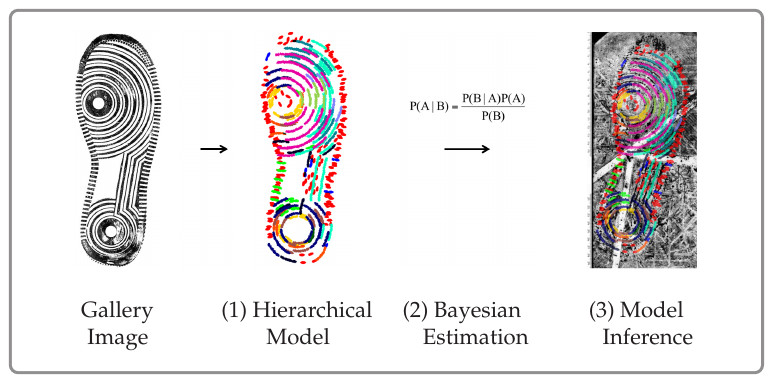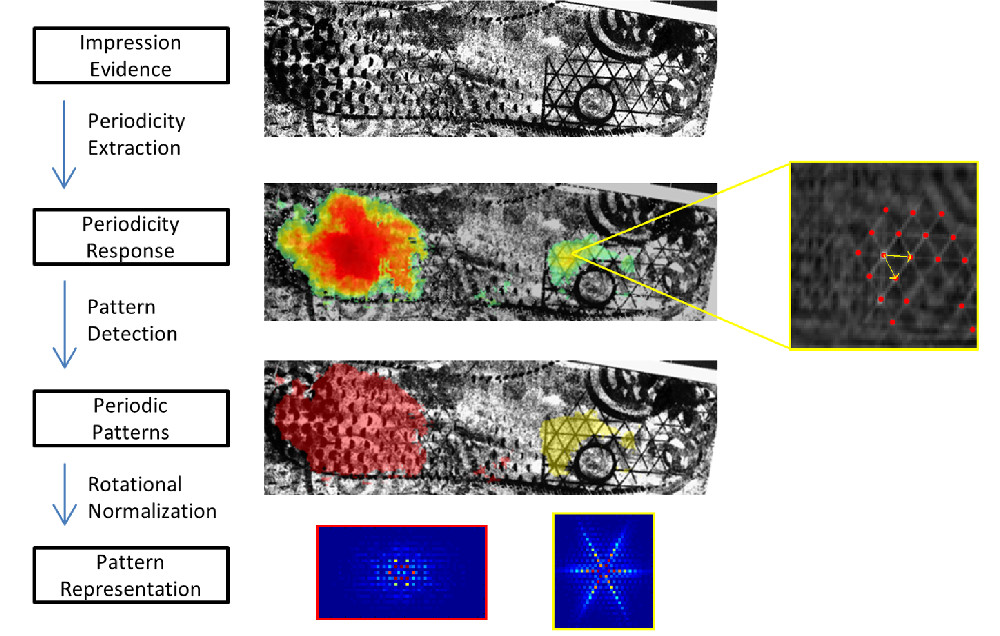
Footwear impressions are one of the most frequently secured types of evidence at crime scenes. A part of the daily life of Forensic experts all over the world, is to assign the crime scene impression to a reference impression. Through this process, the noisy and incomplete evidence becomes a standardized information with outsole images, brand name, manufacturing time, etc. Currently, no automated systems exist that can assess the similarity between a crime scene impression and reference impressions, due to the severe image degradations induced by the impression formation and lifting process.
The impression analysis task combines several challenging problems and therefore is at the heart of pattern recognition research. The main challenges are the combination of unknown noise conditions with rigid transformations and missing data. Furthermore, training and testing data are scarce. Additionally, in many cases no point-to-point correspondence exists between the reference impression and the probe (see Figure above). Therefore, a higher level understanding of the patterns is necessary in order to solve this task.
Database Download
The databases contain samples of footwear impression evidence, that have been secured at crime scenes by forensic experts. The digital images were produced either by scanning gelatin lifters or by photographing the impression. Moreover, 1175 reference impressions are included in the databases. The reference samples have been produced by applying gelatine lifters to the outsole of the reference shoe, followed by scanning the lifters. Thus, the data generating process is very similar for both types of impressions. The data is labelled, meaning that for each crime scene impression, the name of the corresponding reference impression is known.
FID-300
The database can be downloaded at the following link: Download FID-300CSFID-170
This database is a subset of the FID-300 database. It was introduced in [2] and contains mostly footwear impressions with periodic patterns. Download CSFID-170If you use the above data, please make sure to cite [2].
The data is for research purposes only.
Publications
[1] Probabilistic Compositional Active Basis Models for Robust Pattern Recognition
Adam Kortylewski, Thomas Vetter. BMVC 2016 PDF

Abstract: Hierarchical compositional models (HCMs) have recently shown impressive general- ization capabilities, especially with small amounts of training data. However, regarding occlusion and background clutter experimental setups have been relatively controlled so far. The contribution of this paper is two-fold. First, we introduce a greedy EM-type al- gorithm to automatically infer the complete structure of HCMs. Second, we demonstrate how HCMs can be applied to the robust analysis of patterns under structured distortions. The proposed compositional active basis models (CABM) are embedded into a proba- bilistic formulation of the learning and inference processes. Building on the statistical framework, we enhance the CABM with an implicit geometric background model that reduces the models sensitivity to outliers due to occlusions and background clutter. In order to demonstrate the robustness of the proposed object representation, we eval- uate it on a complex forensic image analysis task. We demonstrate that probabilistic CABMs are capable of recognizing patterns under complex non-linear distortions that can hardly be represented by a finite set of training data. Experimental results show that the forensic image analysis task is processed with yet unseen quality.
[2] Unsupervised Footwear Impression Analysis and Retrieval from Crime Scene Data,
Adam Kortylewski, Thomas Albrecht, Thomas Vetter. ACCV 2014, Workshop on Robust Local Descriptors. PDF

Abstract: In this work, we introduce an unsupervised image retrieval algorithm that overcomes the limitations of existing work by detecting and analyzing periodic patterns in the footwear impressions under unconstrained noise conditions. The basic idea behind our approach is that periodic structures are the most preserved information under unknown noise conditions because of their inherent redundancy.
We first extract the periodicity at each point in the impression evidence. Then, we compute Fourier features and use these to detect the periodic patterns. Finally, the periodic patterns are represented by the rotationally normalized Fourier features.
Contact
Please contact Adam Kortylewski if you have any questions or comments regarding this work or the database.
Acknowledgements
We thank the German State Criminal Police Offices from Baden-Wuerttemberg, Bayern, Brandenburg and Niedersachsen and forensity AG for providing the data and supporting its publication.